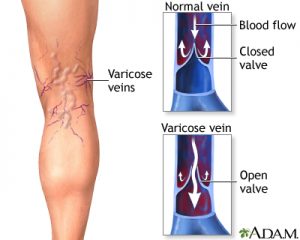When someone says varicose veins, generally the first thing you think of is twisted and bulging veins on the legs or a pattering of small red spider veins around the feet and ankles. While this might be the easiest way of spotting varicose veins, it’s not the only symptom.
Are varicose veins always visible?
The veins in your body form a complex and deep-running network that reaches from the muscle closed to your bones all the way out to just under the surface of your skin. Any vein in your body can be affected by varicosity, though the vast majority of varicose veins occur in the feet and legs. Generally, these veins are close to the surface and become visible when swollen or varicose.
However, some of the deeper veins in your upper and lower legs, as well as your pelvis, can develop into varicose veins without any visible change on the surface of your body, making it harder to tell if you’ve got them or not.
Learn more: Superficial veins and deep veins: what’s the difference?
Should I be worried if my varicose veins aren’t visible?
While you can develop varicose veins that remain invisible to the naked eye, it’s not the secret unseen threat you might think.
Varicose veins often lead to associated symptoms like swelling, heaviness in the legs, aching, itchiness or even a burning situation, and the presence of these symptoms, regardless of visible veins, should prompt a discussion with your GP or vein specialist.
To learn more: Varicose vein symptoms
Thankfully, varicose veins in themselves don’t cause distress in the majority of cases, with the risk of complication relatively low when they appear. However, they can often be indicative of underlying issues, and if untreated they pose a risk to your vein health as well as other potential issues.
How do I treat something I can’t even see?
Ultrasound imaging technology allows for specialists to have a look at all your veins, whether they’re just under the skin or deep in your thighs. Detecting these is relatively simple for a vein specialist, so if you’ve got any of the following symptoms, contact a vein specialist and ask about booking a consult:
- Swelling in the legs, particularly around the calves and ankles.
- Aching or painful sensation in the legs, particularly at the end of the day.
- Spider veins or varicose veins visible in the legs.
- A heavy feeling in the legs, normally at the end of the day.
If the specialist confirms the presence of deeper varicose veins that you can’t see, they can treat them as easily as the surface veins to help alleviate the symptoms and provide you with relief. This is most commonly done with laser ablation and/or sclerotherapy, both of which are relatively simple and pain-free procedures that take less than an hour.
Not sure if you have varicose veins or spider veins? Try our Vein Tool.
Seek expert advice
The doctors at The Vein Institute specialise in varicose vein treatment. We offer patients a comprehensive program using non-surgical laser treatment techniques. You can learn more in our Definitive Guide to Varicose Vein Treatment.
The benefits of non-surgical varicose vein treatment are:
- Walk-in walk-out treatment
- 98% success rate
- Extremely effective
- Can be performed at a clinic (no hospitalisation)
- No general anaesthetic
- Medicare rebates apply
- No downtime or time away from work
To book a consultation and discuss our treatment program, call 1300 981 402. Or, make an enquiry via the Contact Us page.


